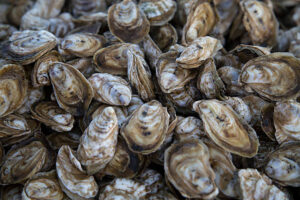OYSTERS

By Terri Estes
Oysters are a type of bivalve mollusks, which mean they have two shells connected by a hinge ligament. The type of oyster that is found in this area is the Eastern oyster. Oysters are very important to our water quality. They are filter feeders, meaning they filter water to extract plankton and other small particles for food. This process helps improve water quality by removing pollutants and excess nutrients. Oyster reefs also support a diverse array of marine life, contributing to overall biodiversity in coastal areas. Many species rely on oyster reefs for food, shelter and breeding grounds.

The Eastern oyster does not form pearls like many other types of oysters, but it is arguably the most flavorful of all oysters. I’m not sure who came up with the idea that oysters looked delicious and should be consumed — RAW, mind you — but it was a genius move. Actually, the consumption of oysters can be traced back to the Stone Age. Archeologists believe that oysters were placed over fire or heated stones to open the oysters up because early humans probably didn’t have tools to open the shells.
The history of oysters in New York is rich and multifaceted, spanning centuries and playing significant roles in both the ecology and economy of the region. Oysters were abundant in the waters around New York City, particularly in areas like New York Harbor, the Hudson River estuary, and the Long Island Sound. This is because oysters thrive in brackish water, and these areas have freshwater from rivers and streams mixing with saltwater from the ocean to create ideal oyster habitats. Some biologists estimate that the New York Harbor contained half of the world’s oysters before the 19th century.
Native American tribes in this area harvested oysters long before Europeans arrived here. During the colonial period, oysters were a staple food for European settlers in the New York region. They were plentiful and easy to harvest and provided a reliable source of nutrition to early settlers. In the 19th century, a boom in oyster harvesting and consumption occurred in New York City. Oysters were cheap and readily available, so they became a popular food for working-class New Yorkers. Oyster bars and oyster saloons became common fixtures in the city, serving oysters in various forms, including raw, fried, stewed and oyster cocktails. Long before pizza and hot dogs, oysters were known as the quintessential New York food.
By the late 19th century, overharvesting, pollution and habitat destruction took a huge toll on wild oyster populations. The original oyster population around New York was capable of filtering all of the water in New York Harbor in a matter of days. Because of the depleted stock and an increase in polluted waters, the oysters were not on a sustainable track. The last of the New York oyster beds was closed in 1927 due to toxicity.
It wasn’t until after 1972’s Clean Water Act that any improvements were seen. Even after 40 years, the oysters around NY Harbor are still not edible. Several projects are underway to help restore oyster populations and improve the health of oyster habitats in and around New York City. The more oysters we have in our waters, the cleaner the waters will be and hopefully, someday, we will once again be the oyster capital of the world.


